Featured Articles
THE BREAKDOWN: Abner Mares-Anselmo Moreno
 Readers, weigh in on Wylie's take, and add your own prediction in our Forum. Do you like Mares (left) against the underrated Moreno? (Hogan)
Readers, weigh in on Wylie's take, and add your own prediction in our Forum. Do you like Mares (left) against the underrated Moreno? (Hogan)
Along with Nonito Donaire and Guillermo Rigondeaux, Anselmo Moreno {33-1-1 with 12 Kos} and Abner Mares {24-0-1 with 13 Kos} are considered two of the best super bantamweights in the world. They will meet this Saturday at the Home Depot Centre in California, Los Angeles. Mares’ WBC title will be on the line.
Even though Moreno, 27 years-old, has never campaigned at 122 pounds before, the skilled southpaw technician shouldn’t be at a loss fighting at a slightly higher weight class. Having dominated at 118 pounds, Moreno hasn’t lost a fight in more than 10 years. His last defeat, a split decision to Ricardo Molina back in 2002, has since been twice avenged. Because of his 28 fight-winning streak in the bantamweight division, some consider Moreno to be one of the top pound for pound fighters in the world. There were times during his last two fights against Vic Darchinyan and David De La Morra where Moreno looked every bit as good as those currently residing the pound for pound list.
Abner Mares, 26 years-old, is on a bit of a run himself at the moment. Going undefeated in boxing isn’t the be all and end all, but when you consider that he’s probably faced the sternest opposition available to him outside of Carl Froch, it’s quite the accomplishment. Being new to the division himself -having only fought at 122 pounds just the once when dominating veteran Eric Morel in his last outing- Mares will need to be at his absolute best if he’s to topple his Panamanian opponent. A win over Moreno would certainly be a career best win for the young Mexican.
The bout is intriguing in that both men will be presenting each other with severe stylistic equations; Moreno’s southpaw angles, defense and counterpunching ability and Mares’ well rounded attack, high volume and grit, will surely test one another to the full.
Using video clips along with analysis below, I’ll be highlighting some of the key elements in each fighter’s style and how they could affect the outcome of the fight.
Anselmo Moreno
Moving off at an angle
The staple of Anselmo Moreno’s game is his footwork. What makes Moreno’s movement so effective is how he nearly always manages to get himself on the blind side of an opponent so that they’re constantly being made to turn and never setting themselves.
{youtube}iSir0i7l_hE{/youtube}
Within the first few minutes of his fight with Frederic Patrac, you’ll see Moreno demonstrate one of his signature moves multiple times. Notice how Moreno circles Patrac in a counter-clockwise motion {he’s a southpaw, remember} before sliding off Patrac’s left shoulder behind a double jab. By circling towards the left side of Patrac, who’s an orthodox fighter, and then moving off behind him, Moreno has done two things.Firstly, he’s taken away his opponent’s right hand threat. If Patrac is going to attempt to land or even throw his trailing hand, he’s going to have to punch across himself, which in turn hinders his power and technique while also making him more vulnerable to counters. And secondly, Moreno’s movement forces Patrac into squaring himself up. Notice Patrac’s alignment in relation to Moreno’s left shoulder. Moreno’s footwork always forces Patrac into lining himself up with Moreno’s left hand.
Also, if you skip to around the 5:40 mark of the video, you’ll see another of Anselmo Moreno’s common manoeuvres. Notice how Moreno baits Patrac into following him to the ropes. As Patrac closes the distance, Moreno moves to his left, before quickly reversing his movement and exiting to his right behind a right hook as Patrac is stepping in. This evasive technique was also a favourite of Pernell Whitaker, a fighter who Moreno has often been compared to such is the similarities between their styles.
Abner Mares is no crude slugger, but he can sometimes square himself up on the inside. Moreno’s ability to constantly be on the shoulder of an opponent could make Mares’ job of finding him frustrating.
Ducking under punches
Another of Moreno’s key defensive attributes is his ability to avoid and blunt an opponent’s attack by slipping and ducking under their punches. By standing side on, behind his right shoulder, Moreno is very tough to hit with single power shots from the trailing hand.
{youtube}HxZ_73CH1bY{/youtube}
Vic Darchinyan is an overly aggressive fighter. When an opponent forces the action as hard as he does, it isn’t always wise to give them their desired momentum simply by moving away from their attack. A perfect example of Moreno’s effective slipping and ducking can be seen at the 21:15 mark of the video. As Darchinyan tries to land a right jab followed by a left cross, Moreno quickly steps back, ducks under the hook and into a clinch with Darchinyan, forcing a separation by the referee. This happened again and again throughout the fight –also check out 19:00 and 35:03 for further examples of Darchinyan missing with his left hand over the top as Moreno’s ducking under. Yes, Moreno uses a plenty of lateral movement in the ring at times, but it’s his superb upper body movement when slipping and countering that takes his defensive craft to another level, as evident in the video below.
{youtube}SnhOyz2TBKA{/youtube}
Notice at 3:36 how Moreno’s subtle upper body movement causes De La Morra to misjudge the distance and over extend with his jab. After slipping inside, Moreno counters De La Morra’s jab {as he’s bringing it back} with a right hook over the top followed by a left uppercut to the body. This is high level counterpunching.
Combination punching
Moreno’s combination punching is truly excellent. By looking at this brilliant highlight package below, you’ll see numerous examples of Moreno’s stellar combination punching which he also integrates into his counterpunching -Moreno prefers to counter using single shots, but he’s also very effective at stringing punches together in twos and threes after countering.
{youtube}bX0YzJ58Oa4{/youtube}
As I’m sure you’ve noticed in the video above, one of Moreno’s favourite combinations is a double jab, left straight, right hook to the body or head. What makes this combination so effective is;
1. It’s unpredictable in that it involves doubling up with the same hand and uses multiple targets by mixing up a head and body attack.
2. By finishing the combination with his lead hand, Moreno is always in balance after he’s finished punching, leaving himself less vulnerable to counters and also in position to defend.
In the pocket
When we think of fighting in the pocket, we tend to think of Henry Armstrong overwhelming his opponents with wave after wave of unrelenting pressure. There’s more to being effective in the pocket than just applying pressure. Defensive mastery on the inside is equally important. Although he’s probably at his best when moving laterally and working behind his jab, Moreno is supremely adept working at close quarters, both offensively and defensively, as his 2008 fight with Rolly Matsushita shows.
{youtube}LJKZH8p225Y{/youtube}
Take a look at 26:42. Notice how Moreno ducks a left uppercut before countering with a right hook to the body. Then at 26:47 as Matsushita presses the attack, Moreno again counters, this time by way of a left uppercut after blocking a Matushita left hook on his elbows. Moving on to the 26:52 point, Moreno forces Matsushita to miss with four consecutive blows – a left hook and right hand {slipped and elbow blocked by Moreno} followed by a right hook and a right straight {both missed their mark because of Moreno’s excellent upper body movement}. Notice how all of these exchanges took place at close quarters. Moreno is standing in range and avoiding everything his opponent is throwing at him without running.
Using the same video, starting at 30:50, there’s an excellent sequence highlighting many of Moreno’s key attributes.
30:50 Moreno evades a jab by sliding off to his orthodox opponent’s blind side by pivoting on his front foot in a counter clockwise motion while using his elbow to deflect the blow as he turns
30:58 Moreno lets his hands go by throwing a right jab followed by left uppercut, then a straight left, right uppercut, left straight.
31:10 again, Moreno turns his man as he slides off to Matsushita’s blindside. As Matsushita jabs, Moreno pivots while guarding his head with his elbow, before slipping a follow up right hand.
31:26 as Matsushita launches an attack, Moreno shows him the right shoulder in close and begins to slip and counter. During the exchange, nothing lands clean on Moreno, who conversely, pretty much lands with everything he throws -straight left hand, right hook and left uppercut.
Mares is excellent on the inside, particularly with his lead hand, but Moreno is a very intelligent fighter who can neutralize a certain weapon through positioning himself in a certain way. Moreno’s side on stance behind his right shoulder is designed to stymie and frustrate. Mares will have to be very creative if he’s to get beyond Moreno’s defensive construct.
Abner Mares
Doubling and tripling up with the lead hand
A common trait of Abner Mares is to confuse his opponent by throwing multiple punches using his lead/left hand.
{youtube}M_WKmrOjXtU{/youtube}
Although he doesn’t connect, notice how at 02:51 Mares thinks nothing of throwing a lead left uppercut at the head of Yonnhy Perez followed by a left hook to the same target -a very unusual combination to be thrown from the lead hand. Because Mares has very good hand speed, he gets away with this type of attack. If you look at the 03:38 mark, you’ll see yet another example of Mares throwing consecutive punches using his lead hand, this time in the form of a double jab, left hook to the body followed by a left hook upstairs. Most fighters are trained to expect conventional punch patterns i.e. jab-jab-right or left-right-left-right. Despite often leaving himself open, Mares’ opponents can’t seem to fathom what punch is coming next from him because of his ability to throw multiple punches from unconventional angles using his lead hand.
Moreno is tough to hit with single shots because of his punch anticipation and elite level defense. Mares’ high volume, particularly with the lead hand, could have good results against a fighter who relies on countering single shots.
From the outside
Although Mares is probably at his best when he’s on the inside, firing off his short combinations, his boxing ability from the outside is much underrated as this clip of his fight with Yonnhy Perez shows.
{youtube}dSWG2OpD1iQ{/youtube}
From the beginning of the video, notice how Mares is making full use of the ring by employing plenty of lateral movement. At 00:18 Mares begins to step in with combinations –jab, jab, right hand- before getting back out of range again. Notice at 00:24 how Mares uses his jab to separate himself from Perez, who is eager to close the distance. Look at 00:55 how Mares steps in with a one-two before rolling under Perez’s left hook and forcing his way inside where he lands two right hooks to the body during a clinch. These are excellent tactics from Mares.
Left hook to the body
As I mentioned earlier, Mares’ left hand is clearly his dominant hand. Although his jab is good and his uppercuts and left hook upstairs are excellent, one of his key weapons is his left hook to the body as evident in the clip below.
{youtube}3IREq7gSybY{/youtube}
At 01:59 Mares lands an excellent left hook into the side and underneath Perez’s right elbow, followed by a left hook up top. Again, Mares is brilliant at levering his lead hand up top and down below.
At 02:43 Mares is backing up. As Perez steps in with a right hand lead, Mares slips outside of it, lands a left hook to the body and then exits by rolling under a left hook and moving away. Again, brilliant boxing ability backed up by an excellent left hook to the body. At 03:01 we see almost a repeat of the exact same sequence –left hook to the body, then a roll under a left hook.
Because Moreno has excellent head movement, Mares’ body punching could be a key element for him against an elusive southpaw like Moreno.
Head Movement
Although he isn’t quite as gifted as Moreno when it comes to defense, Mares is very good at making an opponent miss with good head movement when he’s in punching range.
{youtube}3IREq7gSybY{/youtube}
At 05:34 Mares makes Perez miss four consecutive blows through head movement. As Perez fires three jabs followed by a right hand, Mares is pivoting clockwise on his front foot, weaving under the punches as he moves. At 05:41 Mares slips inside a left jab. Again, his head movement is solid. At 05:47 Mares rolls under a right hook, lands a left uppercut to the body, and then slips a left hook.
Overhand right
Another of Mares’ best shots is his overhand right.
{youtube}3IREq7gSybY{/youtube}
At 06:51 Mares bends at the waist, takes his head away from the centre and lands an overhand right as Perez is throwing his own right hand. Notice the difference in Perez’s heady and body position as opposed to Mares’ as they’re throwing their right hands. That’s why Mares was successful in connecting with his and Perez wasn’t.
Verdict
Although they hit hard enough to hurt each other, neither of these men are known for their ability to end a fight. Logic suggests that this fight is heading to the scorecards. For me, Moreno is better than Mares in just about every area, whether it be defense, intelligence, skill, you name it. And despite never fighting as a super bantamweight before, at 5’ 8’’ and with a 70’’ reach, he’ll have an advantage in height and length over Mares too. I get the feeling that Moreno will try and make this fight easy for him by keeping Mares, who will likely be the fighter in pursuit, on the end of the jab by attempting to keep the fight at a distance. As I’ve already stated, Mares is excellent at closing the distance by slipping punches before landing short combinations, uppercuts along with overhand rights and lefts. The problem he’ll be faced with, however, is that Moreno is equally as slick on the inside as he is from the outside. I wouldn’t be at all surprised if the action did indeed take place at close quarters only for Mares to find it nigh on impossible to land anything worthwhile because of Moreno’s right shoulder posture defense. On the other hand, I can see Moreno’s straight left landing often, especially against a fighter like Mares who may hold his hands high, but is hittable because he often squares himself up to his opponent {remember, Mares was hit often by the straight left hand of Darchinyan often during their fight}. Ultimately, Moreno should have too much polish and skill for Mares. Yes, Mares is probably faster and possibly hits slightly harder, but Moreno is a technician of the highest order and his ring acumen and timing are good enough to nullify any rate of hand speed that Mares should bring. It’s quite possible that Moreno may find it tough to counter Mares’ combinations by waiting on him, but as he showed against David De La Morra, Moreno’s more than capable of forcing the action behind his own combinations and body attack which are reinforced by a superb defense. Moreno should be able to win a decision based on his superior craft and footwork. Along with Floyd Mayweather and Joan Guzman, I consider Anselmo Moreno to be one of the finest pure boxers/technicians on the planet. It’s going to be very difficult for Mares to impose himself on Moreno, who’s one of the best out there at making an opponent fight his fight.
One final thought. Although I’m picking Anselmo Moreno to win, it’s not inconceivable to think that Moreno could outbox Mares for 12 rounds and still wind up losing a decision. Moreno is a counterpuncher who may opt to fight off his back foot, whereas Mares is high volume and will likely be the one pressing the action. If the fight does indeed go the distance, then Mares could receive the benefit of the doubt in close rounds because of aggression, even though he may not be all that effective with it. Remember, judges don’t see every punch that lands but they do usually see every punch that’s thrown. If Mares is the one coming forward throwing twice as many punches as Moreno, then the judges may feel that he’s the one doing all the work in there and may award him the decision. Remember also, Abner Mares is the hometown fighter here.
Not that anything like that ever happens in boxing of course.
-

 Featured Articles3 weeks ago
Featured Articles3 weeks agoAvila Perspective, Chap. 330: Matchroom in New York plus the Latest on Canelo-Crawford
-
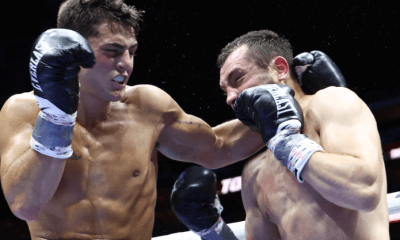
 Featured Articles2 weeks ago
Featured Articles2 weeks agoVito Mielnicki Jr Whitewashes Kamil Gardzielik Before the Home Folks in Newark
-
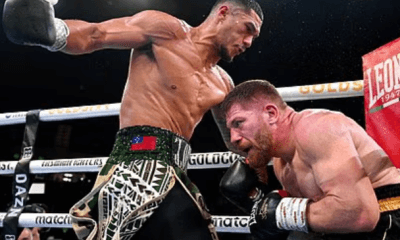
 Featured Articles4 weeks ago
Featured Articles4 weeks agoOpetaia and Nakatani Crush Overmatched Foes, Capping Off a Wild Boxing Weekend
-
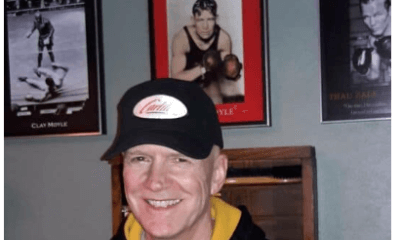
 Featured Articles3 weeks ago
Featured Articles3 weeks agoCatching Up with Clay Moyle Who Talks About His Massive Collection of Boxing Books
-

 Featured Articles4 weeks ago
Featured Articles4 weeks agoFabio Wardley Comes from Behind to KO Justis Huni
-
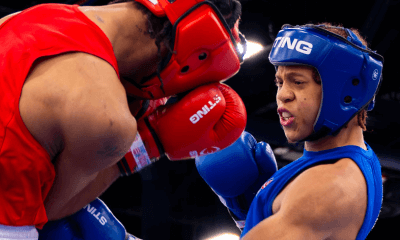
 Featured Articles2 weeks ago
Featured Articles2 weeks agoMore Medals for Hawaii’s Patricio Family at the USA Boxing Summer Festival
-

 Featured Articles3 weeks ago
Featured Articles3 weeks agoThe Shafting of Blair “The Flair” Cobbs, a Familiar Thread in the Cruelest Sport
-
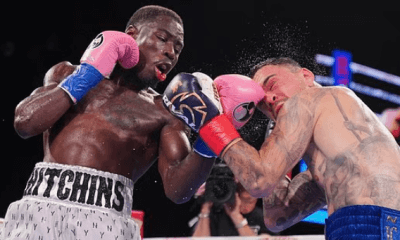
 Featured Articles3 weeks ago
Featured Articles3 weeks agoRichardson Hitchins Batters and Stops George Kambosos at Madison Square Garden
















